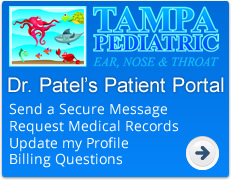|
|
 |
|||||||
Pediatric SinusitisYour child’s sinuses are not fully developed until age 20. Although small, the maxillary (behind the cheek) and method (between the eyes) sinuses are present at birth. Unlike in adults, pediatric sinusitis is difficult to diagnose because symptoms can be subtle and the causes complex. How do I know when my child has sinusitis?
Young children have immature immune system and are more prone to infections of the nose, sinus, and ears, especially in the first several years of life. These are most frequently caused by viral infections (colds), and they may be aggravated by allergies. However, when you child remains ill beyond the usual week to ten days, a serious sinus infection is likely. You can reduce the risk of sinus infections for your child by reducing exposure to known allergens and pollutants such as tobacco smoke, reducing his/her time at day care, and treating stomach acid reflux disease. How will the doctor treat sinusitis?Acute sinusitis: Most children respond very well to antibiotic therapy. Nasal decongestants or topical nasal sprays may also be prescribed for short-term relief of stuffiness. Nasal saline (saltwater) drops or gentle spray can be helpful in thinning secretions and improving mucus membrane function. If you child has acute sinusitis, symptoms should improve within the first few days. Even if your child improves dramatically within the first week of treatment, it is important that you continue therapy until all the antibiotics have been taken. Your doctor may decide to treat your child with additional medicines if he/she has allergies or other conditions that make the sinus infection worse. Chronic sinusitis: If you child suffers from one or more symptoms of sinusitis for at least 12 weeks, he or she may have chronic sinusitis. Chronic sinusitis or recurrent episodes of acute sinusitis numbering more than four to six per year are indications that you should seek consultation with an ear, nose, and throat (ENT) specialist. The ENT may recommend medical or surgical treatment of the sinuses. Diagnosis of sinusitis: If you child sees an ENT specialist, the doctor will examine his/her ears, nose, and throat. A thorough history and examination usually leads to the correct diagnosis. Occasionally, special instruments will be used to look into the nose during the office visit. An x-ray called a CT scan may help to determine how your child’s sinuses are formed, where the blockage has occurred, and the reliability of a sinusitis diagnosis. When is surgery necessary?Only a small percentage of children with severe or persistent sinusitis require surgery to relieve symptoms that do not respond to medical therapy. Using an instrument called an endoscope, the ENT surgeon opens the natural drainage pathways of your child’s sinuses and makes the narrow passages wider. This also allows for culturing so that antibiotics can be directed specifically against you child’s sinus infection. Opening up the sinuses and allowing air to circulate usually results in a reduction in the number and severity of sinus infections. Your doctor may advise removing adenoid tissue from behind the nose as part of the treatment for sinusitis. Although the adenoid tissue does not directly block the sinuses, infection of the adenoid tissue, called adenoid, or obstruction of the back of the nose, can cause many of the symptoms that are similar to sinusitis, namely, runny nose, stuffy nose, post-nasal drip, bad breath, cough, and headache. © 2003 American Academy of Otolaryngology – Head and Neck Surgery
|
| © Tampa Ear, Nose & Throat Associates | Otolaryngology | 3000 Medical Park Drive, Suite 200, Tampa, FL 33613 Privacy Policy | Terms of Use | Notice of Non-Discrimination & Accessibility | Notice of Privacy Practices for PHI Allergies | Facial Rejuvenations | Head & Neck Surgery | Larynx Voice | Nose & Sinus | Office Based Procedures | Pediatric ENT | Snoring & Sleep Apnea Advanced Technology | Cerumen Removal | Septoplasty | Sinusitis | Swimmers Ear | Tinnitus | Tonsils & Adenoids | Vertigo Powered by MedCoData |
